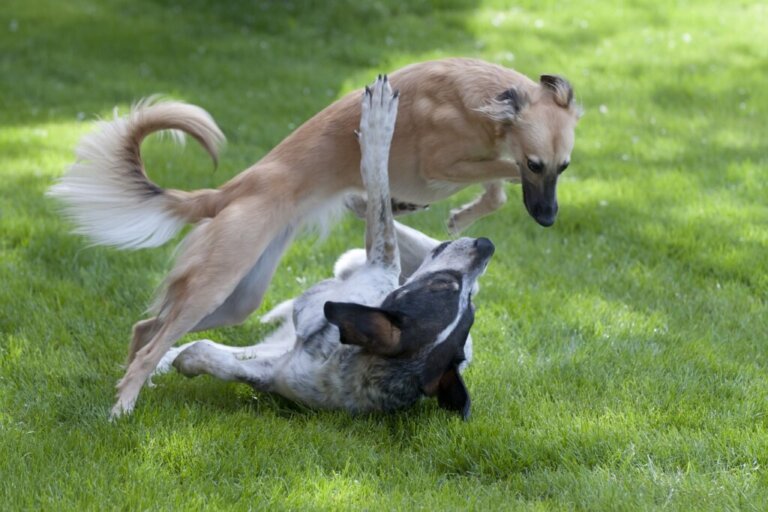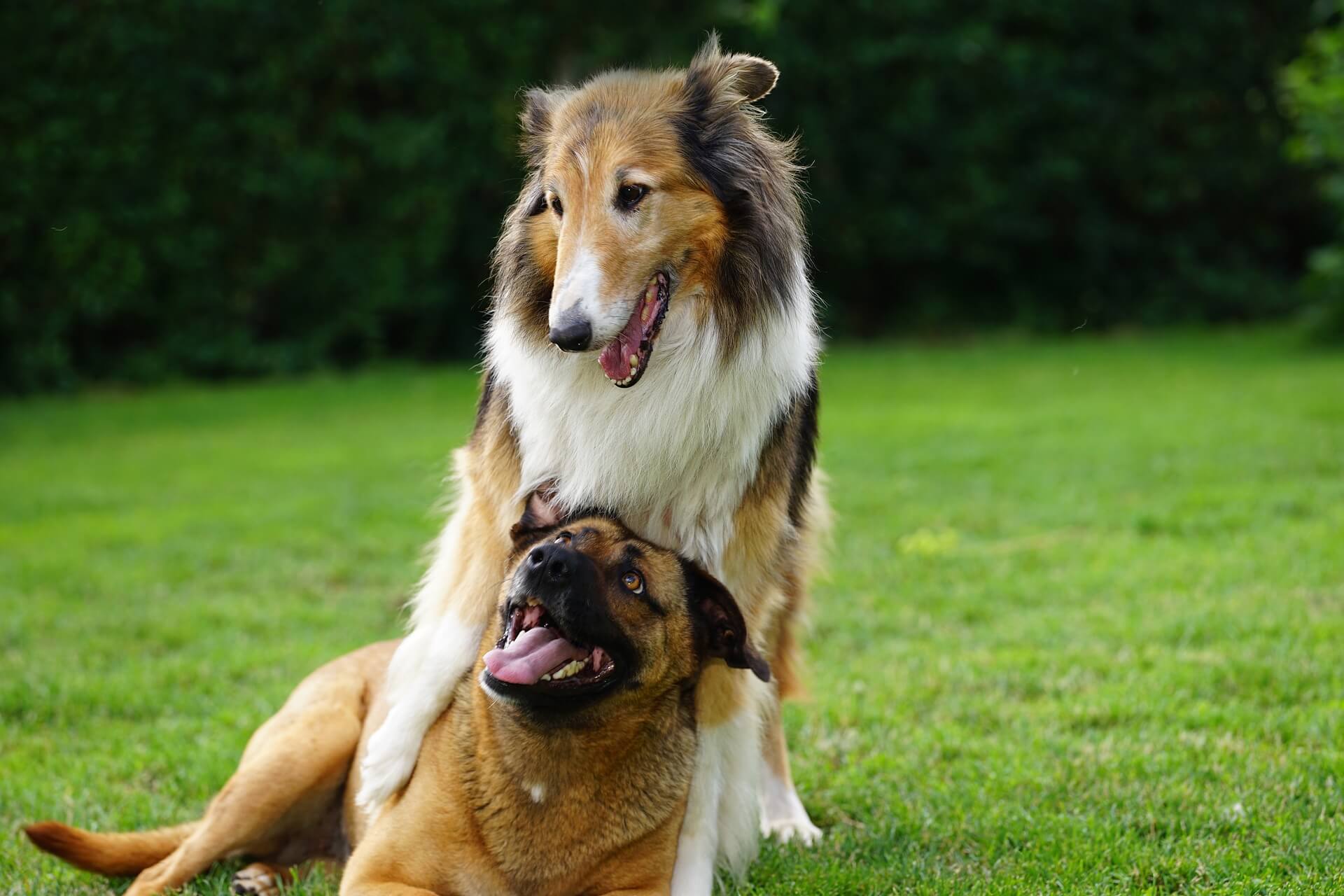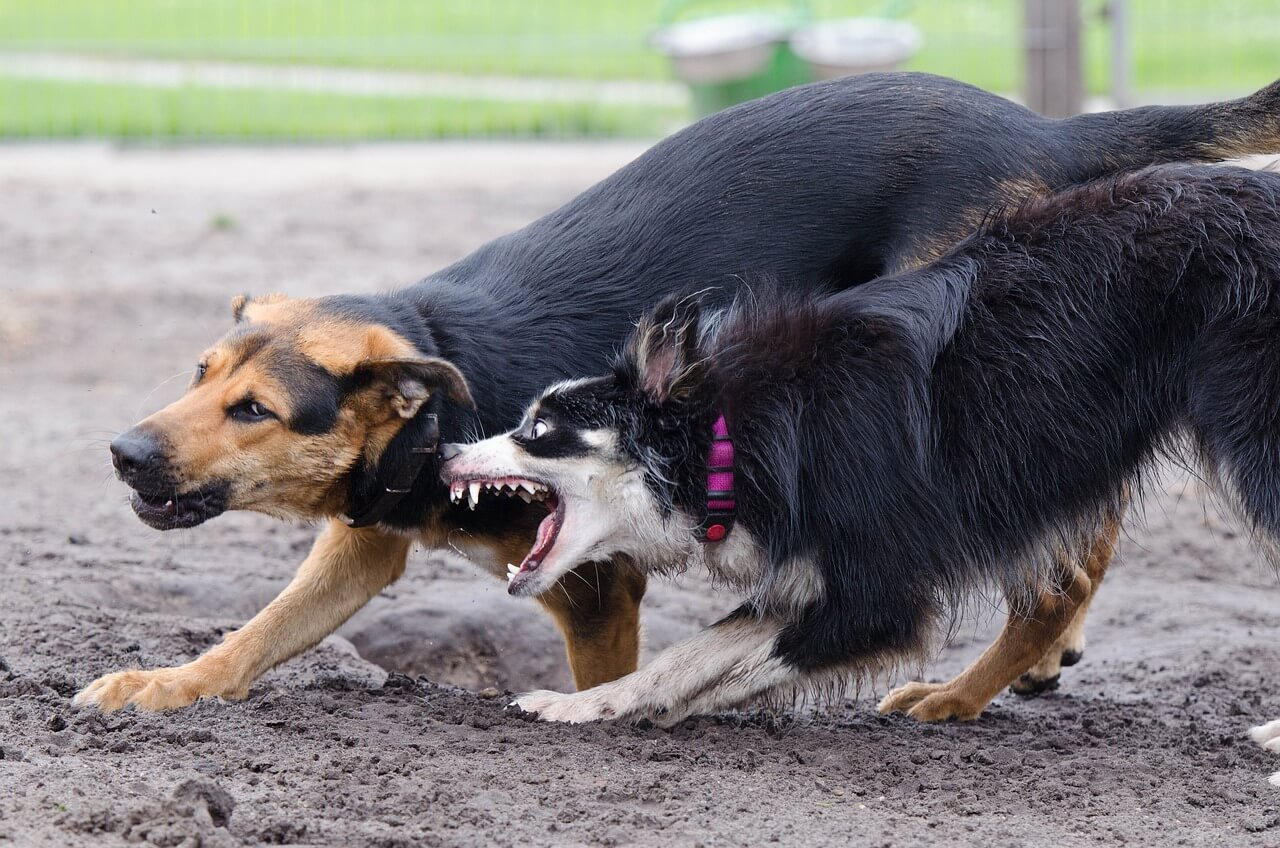Canine Communication: Is My Dog Is Playing or Fighting?


Written and verified by the psychologist Sara González Juárez
Dogs – and especially puppies – play fight. This is natural and part of their socialization process, but sometimes it’s difficult to distinguish when they’re just playing or actually fighting. The signals can be confusing, especially when teeth and claws are involved.
So, how do you read these situations? Some signals that dogs send are capable of being misinterpreted from the human perspective. Let’s get to know the most important signals in the following article. Don’t miss a thing.
Why do dogs play?
Play is a voluntary behavior, which manifests itself in different ways across species. This is explained in a study entitled Why do dogs play? Function and welfare implications of play in the domestic dog.
Furthermore, the authors of this study -Sommerville, O’Connor, and Asher- point out that this phenomenon is accompanied by what they call a “positive affective state.” It also involves time and energy, as well as potential costs: Exposure to injury or disease.
An article published in the journal Applied Animal Behaviour Science argues that social play is a complex interaction between individuals. In it, two levels of behavioral organization are distinguished:
- Lower level: Play is based on actions taken from various contexts, such as predatory, sexual, and agonistic. The latter refers to social behavior related to the struggle or competition between individuals of the same species.
- Higher level: Participants cooperate to achieve the purpose of playing together.
If you’re a guardian who wonders about the reasons that motivate dogs to play, you may find it interesting to know 4 theories, which are presented by the authors mentioned above. They’re as follows:
- Learning motor skills
- Training for unexpected situations
- Building cooperative relationships between dogs
- The effect of other biological processes (such as having a lot of energy)
Canine language can be a mystery to humans. However, there are clues that can be followed. In this regard, research published in Current Biology notes that dogs crouch on their front paws and also raise their buttocks to communicate that they want to play with another dog.
Actions of this type serve to invite other dogs to play. These are signs of honesty and trust, where it’s uncommon for there to be room for deception. This refers to one of the players hiding other intentions, such as mating or dominance. In this regard, according to the aforementioned publication, only 2 to 5% of the rules of play between dogs have been broken.
“I’ve studied social play for decades and have identified four basic rules for fair play, namely, “Ask first, be honest, follow the rules, and admit you’re wrong.” When the rules of play are violated, and when fairness breaks down, so does play.”
Marc Bekoff, American biologist and ethologist
To minimize confusion and doubt, take note of the key signs explained below. These can be helpful when deciphering dog codes and deciphering whether a dog is playing or fighting.
Dog-to-dog play signals

To tell whether a dog is playing or fighting, it’s helpful to pay attention to the previous signals each dog sends. Generally, one canine will invite the other to play with gestures such as the following:
- High-pitched, rapid barking
- A position with the head and elbows close to the ground and hind legs raised
- An erect tail
- Eyes and ears in a position of attention, but without tension in the body
- Quick approaches to the other dog
- Mouth open, tongue out (less common)
The purpose of these signals is to avoid misunderstandings.
With these gestures, the dog indicates that it doesn’t want to fight, but to play. It also serves as a warning before rushing into play. Otherwise, a fight could start unintentionally.
Signs of aggression in dogs
Contrary to what we’ve just read, when a dog wants to attack another dog, the signals won’t be in favor of an approach, but to dissuade the other dog by intimidation. In most cases, dogs avoid physical conflict to protect their integrity. Consequently, they give warnings before escalating to aggression itself.
A study developed at the Autonomous University of Barcelona – dedicated to the evaluation of risk factors and signs of aggression in dogs and cats – specifies the following warning behaviors:
- Showing teeth
- Deep growling
- Bristling back hair
- Rapid marking bites
- Abrupt approaches, without backing away
- Barking
- Clear muscular tension
- Abrupt blows with the muzzle
With these indicators, the canine expresses to others that it doesn’t want to be approached. If the other dog understands this, they’ll move away and there won’t be any aggression. Now, what can you do when an unwanted interaction is initiated? Let’s look at the situation in detail.
Is my dog playing or fighting: Misunderstandings between canines
A playful interaction between dogs can take several paths. Even if they understand each other well and enjoy each other, there’s a chance that this recreational activity can end in a fight. In fact, it’s possible that aggression may result from one of the two dogs not communicating well and unintentionally forcing play. In any of these cases, aggressive behaviors will emerge, so it’s important to differentiate between them.
A harmless game between dogs never ends with injuries. The barking stays high-pitched, the running doesn’t defend space, and when one of them wants to stop, the interaction ends. This is the ideal scenario.
However, when the growling – and vocalizations in general – become serious, the teeth are exposed, and the bites don’t let go, then you’re in the presence of a fight. You may see wounds and the intensity may escalate rather than decrease. At this point, you need to take action.
How to stop a fight between dogs
It’s very important for you to know this: It’s not a good idea to get between two dogs that are fighting. Admittedly, it’s the first impulse you’re going to have, especially if it’s your canine companion that’s in the middle of the conflict. However, if you don’t keep a cool head, you could make the situation worse and even get yourself hurt in the process.
During a fight, don’t lose sight of the fact that dogs can redirect aggression to any approaching person, whether it’s their owner or not. For this reason, physical intervention should be the last resort.
There are several quick and effective techniques that you can use to separate two dogs. According to the American Kennel Club, some of them are as follows:
- Make a loud noise: Use an object to startle them into stopping.
- Wet the dogs: You can do it with a hose or pour a whole bottle of water over them.
- Use some object as a barrier: For example, a stick to put it between them.
- Cover one of the dogs with a blanket or opaque fabric: This way, the other one can be removed from the fight.
There are more desperate and dangerous methods that can be applied only for crucial moments. For example, if you’re talking about a pitbull that has caught a Chihuahua with its teeth and won’t let go, you can cut off the former’s breath with the leash, until it opens its mouth.
This method is strongly discouraged because of the violence involved, but it could be useful to save the life of the assaulted dog.

The importance of socialization
As a dog caregiver, it’s your duty to know how to read your pet’s body language and differentiate when your dog is playing or fighting. But it’s even more important to help the animal socialize correctly, because every dog is unique. Some are more energetic and outgoing, while others are calm – and may have their own set of signals.
Your canine must be able to read the signs of aggression and the signs of calm. The latter are the most relevant, as they’re the ones used by this species to de-escalate conflicts with other members of their species.
Problems are bound to arise if an animal approaches another animal that’s communicating that it’s going to attack.
That’s why, if you detect any problem in this regard, we encourage you to consult a canine ethologist to assist you in your socialization process. A happy dog is one that relates with others in an adequate way with his kind, either playing or greeting each other in the street.
Dogs – and especially puppies – play fight. This is natural and part of their socialization process, but sometimes it’s difficult to distinguish when they’re just playing or actually fighting. The signals can be confusing, especially when teeth and claws are involved.
So, how do you read these situations? Some signals that dogs send are capable of being misinterpreted from the human perspective. Let’s get to know the most important signals in the following article. Don’t miss a thing.
Why do dogs play?
Play is a voluntary behavior, which manifests itself in different ways across species. This is explained in a study entitled Why do dogs play? Function and welfare implications of play in the domestic dog.
Furthermore, the authors of this study -Sommerville, O’Connor, and Asher- point out that this phenomenon is accompanied by what they call a “positive affective state.” It also involves time and energy, as well as potential costs: Exposure to injury or disease.
An article published in the journal Applied Animal Behaviour Science argues that social play is a complex interaction between individuals. In it, two levels of behavioral organization are distinguished:
- Lower level: Play is based on actions taken from various contexts, such as predatory, sexual, and agonistic. The latter refers to social behavior related to the struggle or competition between individuals of the same species.
- Higher level: Participants cooperate to achieve the purpose of playing together.
If you’re a guardian who wonders about the reasons that motivate dogs to play, you may find it interesting to know 4 theories, which are presented by the authors mentioned above. They’re as follows:
- Learning motor skills
- Training for unexpected situations
- Building cooperative relationships between dogs
- The effect of other biological processes (such as having a lot of energy)
Canine language can be a mystery to humans. However, there are clues that can be followed. In this regard, research published in Current Biology notes that dogs crouch on their front paws and also raise their buttocks to communicate that they want to play with another dog.
Actions of this type serve to invite other dogs to play. These are signs of honesty and trust, where it’s uncommon for there to be room for deception. This refers to one of the players hiding other intentions, such as mating or dominance. In this regard, according to the aforementioned publication, only 2 to 5% of the rules of play between dogs have been broken.
“I’ve studied social play for decades and have identified four basic rules for fair play, namely, “Ask first, be honest, follow the rules, and admit you’re wrong.” When the rules of play are violated, and when fairness breaks down, so does play.”
Marc Bekoff, American biologist and ethologist
To minimize confusion and doubt, take note of the key signs explained below. These can be helpful when deciphering dog codes and deciphering whether a dog is playing or fighting.
Dog-to-dog play signals

To tell whether a dog is playing or fighting, it’s helpful to pay attention to the previous signals each dog sends. Generally, one canine will invite the other to play with gestures such as the following:
- High-pitched, rapid barking
- A position with the head and elbows close to the ground and hind legs raised
- An erect tail
- Eyes and ears in a position of attention, but without tension in the body
- Quick approaches to the other dog
- Mouth open, tongue out (less common)
The purpose of these signals is to avoid misunderstandings.
With these gestures, the dog indicates that it doesn’t want to fight, but to play. It also serves as a warning before rushing into play. Otherwise, a fight could start unintentionally.
Signs of aggression in dogs
Contrary to what we’ve just read, when a dog wants to attack another dog, the signals won’t be in favor of an approach, but to dissuade the other dog by intimidation. In most cases, dogs avoid physical conflict to protect their integrity. Consequently, they give warnings before escalating to aggression itself.
A study developed at the Autonomous University of Barcelona – dedicated to the evaluation of risk factors and signs of aggression in dogs and cats – specifies the following warning behaviors:
- Showing teeth
- Deep growling
- Bristling back hair
- Rapid marking bites
- Abrupt approaches, without backing away
- Barking
- Clear muscular tension
- Abrupt blows with the muzzle
With these indicators, the canine expresses to others that it doesn’t want to be approached. If the other dog understands this, they’ll move away and there won’t be any aggression. Now, what can you do when an unwanted interaction is initiated? Let’s look at the situation in detail.
Is my dog playing or fighting: Misunderstandings between canines
A playful interaction between dogs can take several paths. Even if they understand each other well and enjoy each other, there’s a chance that this recreational activity can end in a fight. In fact, it’s possible that aggression may result from one of the two dogs not communicating well and unintentionally forcing play. In any of these cases, aggressive behaviors will emerge, so it’s important to differentiate between them.
A harmless game between dogs never ends with injuries. The barking stays high-pitched, the running doesn’t defend space, and when one of them wants to stop, the interaction ends. This is the ideal scenario.
However, when the growling – and vocalizations in general – become serious, the teeth are exposed, and the bites don’t let go, then you’re in the presence of a fight. You may see wounds and the intensity may escalate rather than decrease. At this point, you need to take action.
How to stop a fight between dogs
It’s very important for you to know this: It’s not a good idea to get between two dogs that are fighting. Admittedly, it’s the first impulse you’re going to have, especially if it’s your canine companion that’s in the middle of the conflict. However, if you don’t keep a cool head, you could make the situation worse and even get yourself hurt in the process.
During a fight, don’t lose sight of the fact that dogs can redirect aggression to any approaching person, whether it’s their owner or not. For this reason, physical intervention should be the last resort.
There are several quick and effective techniques that you can use to separate two dogs. According to the American Kennel Club, some of them are as follows:
- Make a loud noise: Use an object to startle them into stopping.
- Wet the dogs: You can do it with a hose or pour a whole bottle of water over them.
- Use some object as a barrier: For example, a stick to put it between them.
- Cover one of the dogs with a blanket or opaque fabric: This way, the other one can be removed from the fight.
There are more desperate and dangerous methods that can be applied only for crucial moments. For example, if you’re talking about a pitbull that has caught a Chihuahua with its teeth and won’t let go, you can cut off the former’s breath with the leash, until it opens its mouth.
This method is strongly discouraged because of the violence involved, but it could be useful to save the life of the assaulted dog.

The importance of socialization
As a dog caregiver, it’s your duty to know how to read your pet’s body language and differentiate when your dog is playing or fighting. But it’s even more important to help the animal socialize correctly, because every dog is unique. Some are more energetic and outgoing, while others are calm – and may have their own set of signals.
Your canine must be able to read the signs of aggression and the signs of calm. The latter are the most relevant, as they’re the ones used by this species to de-escalate conflicts with other members of their species.
Problems are bound to arise if an animal approaches another animal that’s communicating that it’s going to attack.
That’s why, if you detect any problem in this regard, we encourage you to consult a canine ethologist to assist you in your socialization process. A happy dog is one that relates with others in an adequate way with his kind, either playing or greeting each other in the street.
All cited sources were thoroughly reviewed by our team to ensure their quality, reliability, currency, and validity. The bibliography of this article was considered reliable and of academic or scientific accuracy.
- Bekoff, M. (2015). Playful fun in dogs. Current Biology, 25(1), R4-R7. https://doi.org/10.1016/j.cub.2014.09.007
- Best Friends Animal Society. (s. f.). How to Socialize a Dog. Consultado el 15 de junio 2023. https://resources.bestfriends.org/article/how-to-socialize-dog
- Best Friends Animal Society. (s. f.). Dog Body Language: Signs of Comfort, Stress, and More. Consultado el 15 de junio 2023. https://resources.bestfriends.org/article/dog-body-language-signs-comfort-stress-more
- Bradshaw, J. W., Pullen, A. J., & Rooney, N. J. (2015). Why do adult dogs ‘play’?. Behavioural Processes, 110, 82-87. https://www.sciencedirect.com/science/article/abs/pii/S0376635714002289
- Gibeault, S. (2021, septiembre 29). How to break up a dog fight. En: American Kennel Club. Consultado el 20 de junio de 2023. https://www.akc.org/expert-advice/training/stopping-dog-fight-confrontation-fighting-dogs/#:~:text=Throw%20a%20blanket%20or%20jacket,the%20dogs’%20mouths%20as%20possible.
- Grau, M. A. (2011). Factores de riesgo implicados en el comportamiento agresivo del perro y del gato. Universitat Autònoma de Barcelona. https://dialnet.unirioja.es/servlet/tesis?codigo=90629
- Handelman, B. (2012). Canine Behavior: A Photo Illustrated Handbook. Dogwise Publishing.
- Hecht, J., & Horowitz, A. (2017). Introducción al comportamiento canino. En: Animal Behaviour for Shelter Veterinarians and Staff (pp. 3–30). John Wiley & Sons, Ltd.
- Lockwood, R. (2016). Ethology, ecology and epidemiology of canine aggression. En: J. Serpell (Ed.), The Domestic Dog: Its Evolution, Behavior & Interactions with People (pp. 160-181).
- Mariti, C., Falaschi, C., Zilocchi, M., Fatjó, J., Sighieri, C., Ogi, A., & Gazzano, A. (2017). Analysis of the intraspecific visual communication in the domestic dog (Canis familiaris): A pilot study on the case of calming signals. Journal of Veterinary Behavior, 18, 49-55. https://www.sciencedirect.com/science/article/abs/pii/S1558787816302465
- Pal, S. K. (2010). Play behaviour during early ontogeny in free-ranging dogs (Canis familiaris). Applied Animal Behaviour Science, 126(3-4), 140-153. https://www.sciencedirect.com/science/article/abs/pii/S0168159110001802
- Royal Society for the Prevention of Cruelty to Animals. (s.f). Understanding dog behaviour. En: How to help your dog behave well. Consultado el 20 de junio de 2023. https://www.rspca.org.uk/adviceandwelfare/pets/dogs/behaviour
- Sommerville, R., O’Connor, E. A., & Asher, L. (2017). Why do dogs play? Function and welfare implications of play in the domestic dog. Applied Animal Behaviour Science, 197, 1-8. https://www.sciencedirect.com/science/article/abs/pii/S0168159117302575?via%3Dihub
- Tóth, L., Gácsi, M., Topál, J., & Miklósi, A. (2008). Playing styles and possible causative factors in dogs’ behaviour when playing with humans. Applied Animal Behaviour Science, 114(3-4), 473-484. https://www.sciencedirect.com/science/article/abs/pii/S0168159108000683?via%3Dihub
- Wood, P. A., de Bie, J., & Clarke, J. A. (2014). Behavioural and physiological responses of domestic dogs (Canis familiaris) to agonistic growls from conspecifics. Applied Animal Behaviour Science, 161, 105-112. https://doi.org/10.1016/j.applanim.2010.06.005
This text is provided for informational purposes only and does not replace consultation with a professional. If in doubt, consult your specialist.








